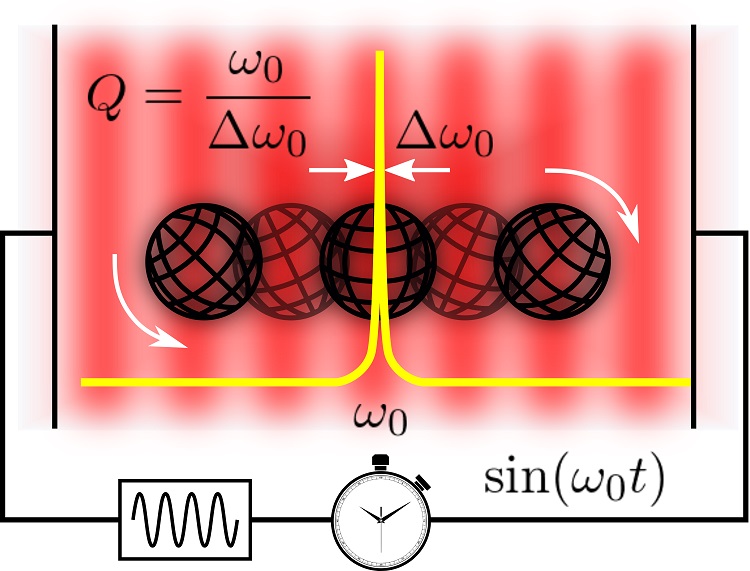Levitated timepiece sets new benchmark

A new mechanical ‘clock’ has been created by an international team of researchers, led by scientists at the University of St Andrews, which could test the fundamental physics of gravity.
The levitated mechanical oscillator, created within a glass sphere the size of a single blood cell, was manipulated by light by the team to create an ultra-sensitive sensor which could measure temperature and pressure changes at the nanoscale.
This highly accurate clock could potentially detect gravity at smaller scales than previously possible and find potential evidence for deviations from Newton’s laws of gravity calling for new physics beyond what we currently understand.
The research, supported by the UK Engineering and Physical Sciences Research Council and the Czech Science Foundation, is published in Science Advances.
Resonance is a phenomenon that is all around us: it occurs when one object vibrates or ‘oscillates’ at the same natural rate as an adjacent second object, this forces that second object to vibrate itself, often showing large motion.
To make sonorous musical instruments, we use resonance between the air and the instrument body. Resonance even explains the sound of the sea that is heard when a seashell is placed up to your ear.
In physics this can be used to great effect with resonators that are the size of cells or even atoms. They undergo periodic motion, akin to a ticking clock, and can drive one another. This leads to ways to make measurements at unprecedented accuracy.
For example, periodic internal jumps in energy (vibrations) in atoms may be linked to external timepieces: these are at the heart of making Global Positioning Systems (GPS) for ultra-precision time keeping. How long this periodic motion can be maintained is determined by the ‘Q’ value. A resonator with a high Q factor rings or vibrates for longer enabling more accurate measurements.
Now researchers from the University of St Andrews in Scotland, the Institute of Scientific Instruments of the Czech Academy of Sciences in the Czech Republic, Chiba University in Japan and Yonsei University in Korea have seen ultra-precise periodic motion in a minuscule glass sphere, the size of a blood cell, held in vacuum by light.
Performing the study in vacuum helped avoid friction which would damp the motion – and reduce the Q value. The team manipulated the light to cause the tiny sphere to move both back and forth and spin in perfect harmony, creating a very well-defined ‘clock’.
The motion of the sphere reached a Q value of more than 100 million, over 100-fold higher than previous reported results for such systems. This motion is very sensitive to any external influence and the team aims to use it to pick up minuscule environmental disturbances, such as changes in temperature and pressure, and even test fundamental physics.
Dr Yoshi Arita, of the School of Physics and Astronomy at the University of St Andrews, and of the Molecular Chirality Research Centre at Chiba University, said: “Unfortunately, even collisions from the sparse gas molecules around the particle can introduce errors in the ticking of our clock (motion of the microsphere) which can limit its precision.
“We corrected these errors by taking a periodic laser signal to drive or ‘nudge’ the microsphere: rather like a child on a swing kicking their legs at exactly the right moment with the swing to get it to make huge swings: this made the motion of our sphere very stable. If this was actually a clock, it would be so accurate that it would only have lost half-a-millionth of a second in a whole day.”
Dr Stephen Simpson, a theoretical physicist at the Institute of Scientific Instruments of the Czech Academy of Sciences, said: “On a microscopic length scale, the motion of a particle is random in nature because of energy fluctuations, but it is amazing to see that nature has also devised a scheme to extract useful work of directed motion from this minuscule machine.”
Professor Kishan Dholakia, of the School of Physics and Astronomy at the University of St Andrews and an affiliate Professor at Chiba and Yonsei Universities, said: “The team has performed a truly outstanding piece of work that we believe will resonate with the international community. In addition to the exciting fundamental physics aspects, the quality of our oscillators set a new benchmark in this field. We aim to explore these to develop the next generation of exquisite sensing devices.”
Category Research